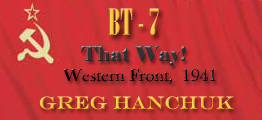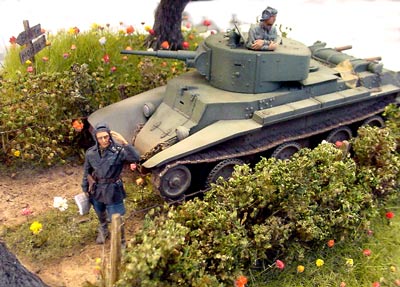|
I have always liked the look of the Soviet pre-war fast tanks, and when I saw the Eastern Express
BT-7 kit at a show I picked it up. Upon opening the box I knew I was in for a challenge.
Dimensionally the kit is accurate, but detail wise it is very soft. I started to gather up
as much reference as I could, and I quickly found most of these tanks never made it past 1942, and
a majority where quickly destroyed when Barbarosa began. I knew I wanted to put this BT-7
in a diorama and I quickly formulated a scene. I planned on having the little tank coming
up a dirt country lane in the late spring, with bushes on either side of the road, and with flowers
blooming in the grass around to add a little color. The tank commander would be out with a
map asking a soldier for directions, getting back on course. With my little scene in mind,
I proceeded to start the build. |
|
![[Index]](../../../Redstar3a.jpg)

![[Index]](../../../Redstar3a.jpg)

![[That Way, Western Front, 1941]](GH-BT-005a.jpg)

![[Photo by Greg Hanchuck]](BT_image006b.jpg)
![[Photo by Greg Hanchuck]](BT_image002b.jpg)
![[Note cast texture on nose piece and rivets - Photo by Greg Hanchuck]](BT_image003a.jpg)
![[the engine deck...]](GH-BT-013a.jpg)
![[Photo by Greg Hanchuck]](BT_image005a.jpg)
![[Nice Pipes...]](GH-BT-014b.jpg)
![[Cool Tools...]](GH-BT-018b.jpg)
![[Rear Stowage Boxs, and those rivets... Photo by Greg Hanchuck]](BT_image008a.jpg)
![[Jordi barrel - Photo by Greg Hanchuck]](BT_image009a.jpg)
![[coaxial machine gun was scratch built - Photo by Greg Hanchuck]](BT_image004b.jpg)
![[Finished Turret]](GH-BT-010b.jpg)
![[Index]](../../../Redstar3a.jpg)